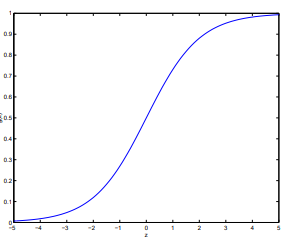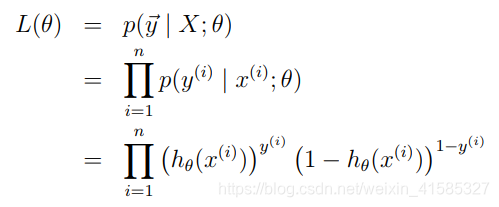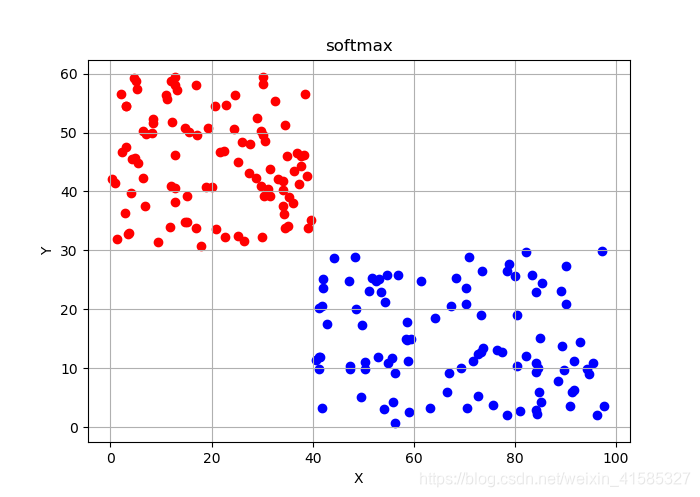Logistic regression algorithm
一.损失函数
1.理论部分
如果我们有一组观察数据 y = {y1,y2,…,yn},一组特征x ={x1,x2,…,xn}(其中x1,x2,…,xn为不同的特征向,xm ∈R ^n) 所以x∈R^(n*n)
我们认为y近似为x的线性方程:
H(x) = θ^Tx
其中θ∈R^n,每一个θn为xn特征的系数
我们定义一个损失函数为:

这个损失函数多了平方是因为凸优化,以方便找到他的最小值,其中1/2为方便之后的计算
然后对这个损失函数对每一个θj 求偏导:

求出偏导后即可直接用梯度上升计算出最大的θj:

2.代码实现
import numpy as np
import random
def gradientDescent(x,y,theta,alpha,m,numliterations):
xTrans = x.transpose()
for i in range(0,numIterations):
hypothesis = np.dot(x,theta)
loss = y - hypothesis
cost = np.sum(loss **2)/(2*m) #m isn't important. In other books,There is m in the loss function
gradient = np.dot(xTrans,loss)/m
theta = theta + alpha*gradient
if i%1000 == 0:
print("Iteration %d | Cost: %f" % (i, cost))
return theta
def genData(numPoints,bias,variance):
''' return training set '''
x = np.zeros((numPoints,2))
y = np.zeros(numPoints)
for i in range(0,numPoints):
x[i][0] = 1
x[i][1] = i
y[i] = (i+bias)+random.uniform(0,1)*variance
return x,y
x,y = genData(100,25,10)
m,n = np.shape(x)
numIterations = 20000 #The number of Iterations
alpha = 0.0005 # learn rate
theta = np.ones(n)
theta = gradientDescent(x,y,theta,alpha,m,numIterations)
print(theta)
二.logistic function(又称sigmoid function)
我是在MIT 18.04的课程学到的这个函数,它的导函数是线性且递增的。

它是二分类问题上运用比较频繁的激活函数,先看该函数的模型:

logistic function的值域只在(0,1)之间,其次图形中中间陡峭而两边平缓,符合二元分类的样本点特性。因此适合用于处理二分类问题。
三. Logistic regression algorithm
1.首先我们重新假设我们有一个二分类问题,观察的标签y∈[0,1](y非0及1),我们观察的特征x∈{x1,x2,…,xn}。
由于我们的特征是
我们假设:

其中 ;后面的θ假设为一个定值 ,意思是P(y=1|x)是与θ值有关
然后我们能更简洁的写成:

(该公式参考伯努利分布)
因此,我们的损失函数可以改写成:

我们对数化一下上面式子(因为log函数也是一个单调递增的函数,极大方便运算):

最后通过对每个θj求偏导,即可得到迭代公式:

虽然与上面的损失函数形式类似,但是要注意这里的y和h(x)∈(0,1).
2.代码实现
代码部分是先生成两组数据。
x为特征储存的向量及二维平面上是点
x[0]为某点的x坐标
x[1]为该点的y坐标
而y为该点的标签
import numpy as np
import random
import matplotlib.pyplot as plt
#logistic function
def sigmoid(x):
return 1/(1 + np.exp(-x))
def gradAscent(dataMatln,classLabels):
dataMatrix = np.mat(dataMatln)
labelMat = np.mat(classLabels).transpose()
m,n = np.shape(dataMatrix)
alpha = 0.001 #learning rate
maxCycles = 30000 # The number of iterations
theta = np.ones((n,1))
for k in range(maxCycles):
h = sigmoid(np.dot(dataMatln,theta))
error = (labelMat - h) #error with labels
#cost =np.sum(np.dot(error.T,error))/2 #
theta = theta + alpha*dataMatln.transpose()*error #Gradient Method
if k%1000 == 0:
print("Iteration %d | Error: %f" % (k, np.sum(error)))
return theta
def genData(numPoints):
''' Return training set and labels '''
x = np.zeros((numPoints,2))
y = np.zeros(numPoints)
count = int(numPoints/2)
for i in range(0,count):
x[i][0] = random.uniform(40,100)
x[i][1] = random.uniform(0,30)
y[i] = 1
for i in range(count,count*2):
x[i][0] = random.uniform(0,40)
x[i][1] = random.uniform(30,60)
y[i] = 0
return x,y
dataMatrix,classmethod = genData(200)
theta = gradAscent(dataMatrix,classmethod)
#Verify algorithm
Classify =np.dot(theta.T,dataMatrix.T) # Classify = theta.T * X
m,n = np.shape(Classify)
Class_One = []
Class_Zero = []
for i in range(0,n-1): #if probability is bigger than 0.5, draw this point in blue
if sigmoid(Classify[0,i]) < 0.5: #else if probability is smaller than 0.5, draw this point in red
Class_Zero.append(dataMatrix[i])
elif sigmoid(Classify[0,i]) >= 0.5:
Class_One.append(dataMatrix[i])
Class_Zero = np.matrix(Class_Zero)
Class_One = np.matrix(Class_One)
plt.figure(figsize = (7,5))
plt.scatter(np.array(Class_Zero[:,0]),np.array(Class_Zero[:,1]),marker='o',c = 'r')
plt.scatter(np.array(Class_One[:,0]),np.array(Class_One[:,1]),marker='o',c = 'b')
plt.grid(True)
plt.xlabel('X')
plt.ylabel('Y')
plt.title('softmax')
plt.show()
3.效果图展示:

红色点是算法计算出标签为0的点,蓝色是标签为1的点。
由此可见这个算法在二分类问题还是非常有效的。




 本文深入探讨了Logistic回归算法,包括损失函数的数学推导、logistic函数的特性及其在二分类问题上的应用,同时提供了详细的代码实现,展示了算法在实际数据集上的有效性。
本文深入探讨了Logistic回归算法,包括损失函数的数学推导、logistic函数的特性及其在二分类问题上的应用,同时提供了详细的代码实现,展示了算法在实际数据集上的有效性。
















 3万+
3万+

 被折叠的 条评论
为什么被折叠?
被折叠的 条评论
为什么被折叠?








